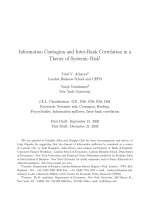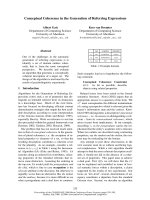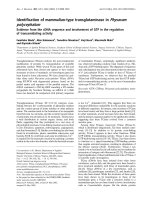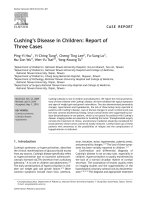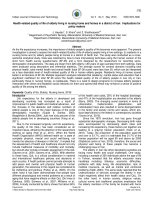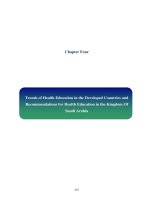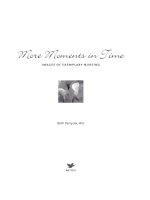More Moments in Time - Images of Exemplary Nursing potx
Bạn đang xem bản rút gọn của tài liệu. Xem và tải ngay bản đầy đủ của tài liệu tại đây (1.42 MB, 249 trang )
More Moments in Time
images of exemplary nursing
Beth Perry rn, phd
©
2009
beth perry
Published by AU Press,
Athabasca University
1200, 10011-109 Street
Edmonton ab
t5j 3s8
Library and Archives Canada Cataloguing in Publication
Perry, Beth, 1957–
More moments in time : images of exemplary nursing / Beth Perry.
Includes bibliographical references.
isbn 978-1-897425-51-0
Also available in pdf format
isbn
978-1-897425-52-7
1. Cancer Nursing. 2. Nursing. I. Title. II. Title: Images of exemplary nursing.
rc266.p47 2009 616.99’40231 c2009-901822-5
Printed and bound in Canada by Marquis Book Printing
Cover design by Helen Adhikari
Book layout and design by Natalie Olsen
This publication is licensed under a Creative Commons License
(see creativecommons.org). The text may be reproduced for non-commercial
purposes, provided that credit is given to the original author.
For permission beyond that outlined in the Creative Commons License,
please contact AU Press at
acknowledgements
Photographic Images: Otto F. Mahler
Stories: The outstanding nurses who generously gave of their time
and emotional energy to help me explore exemplary nursing care.
Research Funding: Social Sciences and Humanities Research
Council of Canada (sshrc)
contents
9
preface: Situating Exemplary Nursing in Health Care Today
Exemplary Nurses and Career Satisfaction
Time to Care
Nurses Respond to Moments in Time: Images of Exemplary Nursing Care
19
chapter one: The Power and Promise of Exemplary Nursing Care
Signicance for Nurses
Signicance for Others
Discovering Meanings
The Organization of this Book
25
chapter two: The Multi-layered Landscape
Caring for People with Cancer
My Memories
45
chapter three: The Dialogue of Silence
Learning to Use Silence
Times When Silence is Useful
The Gifts of Silence
Forms of Silence
Reections on the Dialogue of Silence
79
chapter four: Mutual Touch
Mutual Touch Dened
The Importance of Touch in Health Care
The Nature of Touch
Types of Touch
Touch and Silence
111
chapter five: Sharing the Lighter Side of Life
The Lighthearted Attitude Dened
The Value of Sharing Lightness
Humour Comes in Many Forms
Developing the Attitude
The Trilogy Reviewed
143
chapter six: The Effects of Exemplary Nursing Care
Connecting
Afrming the Value of the Patient
Afrming the Value of the Nurse
Joint Transcendence: Living the Extraordinary
183
chapter seven: Lessons Learned
What Nurses Should Know
Messages Addressed to Everyone
What I Learned About Exemplary Nursing
215
appendix: Research Design and Methodology
Qualitative Inquiry
Hermeneutic Phenomenology
Research Method
243
references
9
preface
situating exemplary nursing
in health care today
Since 1998, when the first version of this book, Moments in Time:
Images of Exemplary Nursing Care, was published by the Canadian
Nurses Association, Canadian health care has changed. Multiple,
potentially interrelated factors challenge Canadian nurses today.
These include personnel shortages, escalating costs and spending,
advances in technology, aging population and longer life expectancy,
increasing cultural diversity, new diseases, growing rates of chronic
diseases, shortened hospital stays, and profound ethical and moral
dilemmas. Challenges often lead to changes such as health care system
reform, evolving scope of practice with new advanced nursing prac-
tice roles, an increased
emphasis on the inter-
disciplinary team, and
new approaches to health
care such as population
health, integrated health
care delivery, and dis-
ease management.
1
Some
argue that such changes
threaten our public health
care system and the fun-
damentals of universality,
comprehensiveness, accessibility, portability, and public administra-
tion. Others contend that these changes have resulted in poor practice
environments and unsatisfactory working conditions for health care
workers, especially nurses. Many question whether we can afford, or
10
mo r e moments i n t ime: im ages of e xempl ary nur s i n g
even expect, exemplary care in a health care system that has become
so complex and burdened.
Beginning with my doctoral research almost 20 years ago, I have
been intrigued with what makes some clinical nurses exemplary. I
defined exemplary nurses as those you would choose to have care for
you or a family member. Clinical nurses (also called bedside or front
line nurses) are those who spend the majority of their work time
relating directly with patients.
*
I believe that clinical nurses are the
foundation of the health care system. We simply cannot have exem-
plary health care without exemplary clinical nurses. Research aimed
at learning more about the actions and attitudes of exemplary clinical
nurses, and the effects of these on patients and on the nurses them-
selves, became the foundation of my program of nursing research.
exemplary nurses and career satisfaction
The findings from my initial research study on the actions, and
effects of the actions, of exemplary nurses are reported in this book.
Since the original project, I have completed several follow-up studies
on related themes. For example, as I continued to study exemplary
nurses, I discovered that they had one important commonality; they
all commented often that they “loved their work.” Exemplary nurses
reported career satisfaction that seemed, at least in part, to motivate
them to continue to provide high quality patient care.
To learn more about this possible link between career satisfac-
tion and quality of care, I launched an international study focused on
professional fulfillment in the work lives of registered nurses (rns). I
found that exemplary nurses who claimed they were satisfied with their
career choices also knew their core values and believed they were able
to enact these values in their workplace.
2
Their core values included
altruism, caring, compassion, and a desire to make a difference. One
*
I have chosen to use the term “patients” but I acknowledge that this group
may be referred to in some health care venues as residents or clients. Their
family and friends are also subsumed into the term.
11
preface: Situating Exemplary Nursing in Health Care Today
important way exemplary nurses were able to make a difference for
their patients was by establishing a connection with them and with
their family members. These nurses found making and maintain-
ing the connections very satisfying. When the nurses that I studied
were able to provide high quality care that patients found helpful,
they felt very fulfilled and found meaning in their work. Living their
values, connecting with patients, and finding meaning in their work
through making a difference established a cycle which propelled the
exemplary nurses to continue to care in an exemplary way.
3
Career
satisfaction and high quality care were the remarkable results.
A framework for career satisfaction in nursing illustrates the pos-
sible relationship between these elements and the living out of core
values.
4
The dominant feature of this model is the cyclical nature of
the positive caregiving experience. That is, as nurses enact their values
in the workplace, connect in a meaningful way with their patients,
and make a positive difference, they may realize that they become
even better nurses by doing their work well and are thus motivated
to continue. It is doubtful that career satisfaction in nursing is as
linear as this model suggests, but it does illustrate the strong rela-
tionship between several elements identified.
When health care administrators, government officials, other
stakeholders, and even nurses themselves question whether we can
afford to provide high quality nursing care in these turbulent times,
I say we cannot afford not to. It is in providing exemplary nursing
care that nurses make a difference to patients and find meaning in
their work. When nurses are professionally fulfilled, they continue
to care at a high level. The resulting exemplary nursing care is not
only good for the patients, it is good for the nurses too.
Another interesting finding that I am currently exploring is that
the exemplary nurses I have studied very rarely report experiencing
compassion fatigue (cf). Compassion fatigue is defined by LaRowe
as a “heavy heart, a debilitating weariness brought about by repetitive,
empathic responses to the pain and suffering of others.”
5
Compassion
12
mo r e moments i n t ime: im ages of e xempl ary nur s i n g
fatigue is a term sometimes confused with burnout although the two
are quite different. Schwam says that, unlike burnout which results
from the stress in one’s work setting that can be reversed by a vaca-
tion or a change in setting, cf is often more insidious with long-term
consequences that are difficult to reverse.
6
With a current research project, I aim to find out what it is about
exemplary nurses that helps them avoid the personally and profes-
sionally devastating experience of cf. I hope that the findings of this
study will have practical implications for nurse recruitment, retention,
and professional well-being, if I am able to discover interventions and
strategies exemplary nurses use to avoid cf.
time to care
A common complaint today among front line caregivers, including
nurses, is that they do not have time to establish meaningful, car-
ing, and potentially transforming relationships with their patients.
The good news is that exemplary nursing care is not necessarily any
more time consuming or expensive to provide than poor quality
care. Admittedly, nurses are extremely busy and stress levels often
run very high. Nurses may feel like they cannot squeeze one more
second out of their work days. Among clinical nurses in particular,
a great potential exists for turmoil, stress, burnout, and
cf.
7
Yet
caring is fundamental to the work of most nurses. As a nurse in
one study told me, “The ability to care is nursing’s common thread,
and when time to express caring is denied, it is a source of frustra-
tion for me.”
How can nurses provide quality care that they find satisfying
within the limits of today’s health care reality? Jackson emphasizes
the importance of here-and-now interactions, saying that instead of
feeling discouraged because of time constraints, nurses should view
all of their interactions as positive and potentially effective.
8
To this
end, I remind nursing students and the novice nurses I teach that it
does not take any longer to administer a medication with a smile on
13
preface: Situating Exemplary Nursing in Health Care Today
your face than it does to give the same medication with a frown. It
does not take any longer to gently rub the vein you are about to use
to start the intravenous than it does to beat that vein into submis-
sion. The effect of the smile and gentle approach on the patient, and
ultimately also on the nurse, is positive.
Hagerty, et al. concluded that, ideally, caregivers should have
as much time as possible to be with patients.
9
When time is short,
however, caregivers need not feel all is lost because every encounter
between a nurse and patient can be a valuable relational moment.
Each caring encounter, no matter how brief, can be important to the
therapeutic relationship. For a highly skilled nurse, the connection,
the experience of caring and being cared about, can happen in mere
moments through the right touch, word, or listening ear. Often what
patients need most is something that really does not take any extra
time
—
a nod, a compassionate glance, or a hand placed on a shoul-
der at just the right moment make a positive difference for a patient
and, ultimately, for the nurse as well.
Brenda,
†
an
or
nurse I met, gave me an example to illustrate these
points. It was a note sent to her by the wife of one of her patients:
You probably don’t remember me, but I wanted to
thank you for your care. My husband and I had been
in a traffic accident. The police called it a “minor traffic
mishap” and after being checked over at the hospital we
were both sent home. I was a little shaken and bruised,
but we were both pronounced “just fine.” As the week
progressed I had a very disturbing dream. I dreamed
that my husband was in the hospital and that he was
having a cardiac arrest. I stood hopelessly by watching
the team try to revive him.
The names of the nurses, patients, and family members used in this book are
all fictitious.
†
14
mo r e moments i n t ime: im ages of e xempl ary nur s i n g
Imagine my horror when later that week, after he was
pronounced just fine and had returned home, my hus-
band did start to experience some perplexing symptoms
and, after a consult at the emergency room, was rushed
into surgery for the removal of a ruptured spleen.
The time was long as I waited, pacing the hallway out-
side the operating room waiting for some word on how
he was doing. I was haunted by the strange dream and
terrified that my husband was not going to make it
through the procedure. Then I caught a glimpse of an
or nurse through the small window in the door that
separates the operating area from the waiting room.
That nurse was you. You were still in your scrubs and
all I could see behind the green mask were your eyes.
You must have seen the look of concern on my face. As
you whisked about doing your post-op duties you lifted
one hand and gave me the a-okay sign, your thumb and
pointing finger forming a circle. This gesture took only
a portion of one second, but it was all I needed to know
he was all right. I just wanted to say thank you. That
kindness meant so much to me.
—
little moments
A simple gesture.
Compassion offered. Peace received.
—
A bed bound patient once told me of his favorite nurse, calling her
“the one who really cared.” When I asked him what was different
about this particular nurse, he said, “Every time she came into my
room, she would give my big toe a little tweak.” He perceived this
small action as acknowledgement that made him feel connected
to the nurse and cared about. Tweaking his toe took the nurse no
15
preface: Situating Exemplary Nursing in Health Care Today
extra time at all. Scott wrote that it is the human connection
—
that
largely intangible, immeasurable, unquantifiable aspect of nursing
practice
—
that nurses value most, and it is also the human connec-
tion that patients often need and desire.
10
Clinical nursing is a demanding career. No one can be an exem-
plary clinical nurse without a very sound knowledge base and excel-
lent psychomotor skills. But I have also observed that the way that
care is provided
—
the attitude and aura of the nurses and their
ability to convey compassion and caring
—
helps to make the care
they provide exemplary. Having this certain attitude and air is not
time consuming.
nurses respond to
Moments in Time: Images of Exemplary Nursing Care
My 1998 book, Moments in Time: Images of Exemplary Nursing Care, was
embraced by the nurses of Canada and all copies were sold. For expe-
rienced nurses, the stories reminded them why they chose this career
and helped to reignite their passion for their profession. For the novice
nurse and the nurse educator, the book was a teaching tool because it
modeled effective nursing care strategies and attitudes. Additionally,
nurse educators have suggested that this book could be used in first year
undergraduate nursing courses on professionalism, communication,
or socialization. Others have commented that it could be an exemplar
of qualitative research for graduate health care courses. Instructors in
nursing attendant and personal health care aide programs have sug-
gested that the stories in the book could help to teach the enigmatic
skill of caring. Other health care professionals, including pastoral care
workers, rehabilitation therapists, and volunteers, have also read and
valued this book and asked for more. Some have commented that the
stories and analysis in this publication helped to differentiate nursing
from medicine and, in doing so, helped us toward a definition of nurs-
ing. As another consequence of the book’s success, I gave over 30 key-
note presentations at national and international nursing conferences.
16
mo r e moments i n t ime: im ages of e xempl ary nur s i n g
Ongoing requests for a reprinting or a new edition of the original book
ultimately resulted in the publication of the book you are now read-
ing. I hope that this updated version will contribute to scholarship in
the field of nursing and to health care in general.
The lessons in this book speak of values and actions that lead not
just nurses and other health care providers, but all humans, to become
better. Readers of Moments in Time with no professional connection
to health care told me, “I’m not a nurse but what you found applies
to all of us,” and “I felt so good after reading your book, it made me
want to go out and treat my fellow man better.”
For all those who have asked, I hope you enjoy this revised and
updated version, More Moments in Time: Images of Exemplary Nursing.
To the original stories and analysis, several new components are
added. The preface situates exemplary nursing care in the context
of the health care environment of 2009. It also features a discussion
of findings of additional research on career satisfaction in exemplary
nurses that arose from the original study.
Chapter 2 furthers my self-story, the multi-layered landscape of
the researcher (who in qualitative research is the instrument of data
collection and analysis). Since writing the original book, I have had
many personal and professional experiences that have shaped what I
see, believe, and know about exemplary nursing care. The assumption
is that you cannot recognize what you, yourself, have not known. I
hope that the additions to the section “My Memories” will give read-
ers an insight into these influences on my research.
I have updated the citations of scholarly literature that support
and enhance understanding of points made in the book. In 1998,
Moments in Time was considered cutting edge because there were very
few phenomenological nursing studies of exemplary nursing care.
‡
Phenomenology/phenomenological/hermeneutic phenomenology
—
a
qualitative research tradition that focuses on the lived experience of humans.
Phenomenology becomes hermeneutical when its method is taken to be
interpretive (see the Appendix for more details).
‡
17
preface: Situating Exemplary Nursing in Health Care Today
Such approaches were new to the landscape of nursing. Now a new
generation of nurse researchers have used phenomenology to try to
capture and share the essence of nursing practice. References through-
out this revised edition cite these recent studies. Other topic areas in
the book, such as humour, silence, touch, and connection, have also
benefited from newer research so I have cited these sources.
As I presented my research findings to audiences at conferences and
workshops, I sought ways to help convey the tacit, unspoken aspects
of the intense human to human interaction that often occurred in
exemplary nursing situations. To do so, I turned to writing poems
that help to capture the essence of an interaction in very few words.
(My process is explained in detail in the Appendix.) I also experi-
mented with using photographic images during presentations to
help evoke the emotion of the story being told. Many people noted
that these images gave voice to the people in the stories, again with-
out words, which can sometimes be limiting and imposing. I have
included an example of an image used to help convey the deeper
meaning of the theme at the beginning of each chapter in this new
edition. The poems in which I attempt to capture the essence of the
nurse-patient interactions in a phenomenological sense are placed
throughout the revised book.
Finally, an Appendix has been added for those who are interested
in the research design and the methodology used in the study which
forms the foundation of this book. Beginning with a brief exploration
of the nature of qualitative inquiry, a case is made for its use in nurs-
ing investigations that focus on human experience. The methodology
used in the study, hermeneutic phenomenology, is explained. Specif-
ics about the study participants, approaches to data collection, and
methods of data analysis are described. Techniques used to maintain
data trustworthiness, assumptions made, delimitations and limita-
tions of the study, and ethical considerations are included.
To those who read the original book and provided me with help-
ful feedback and critique, thank you. Many said that it reawakened
18
mo r e moments i n t ime: im ages of e xempl ary nur s i n g
in them their own lived experience as nurses and caregivers. I have
not given a presentation based on this research without several peo-
ple approaching me afterward to tell me their stories. To me, this is
the true test of phenomenology. The research sparked memories
of your own lived experiences as exemplary nurses, or exemplary
human beings. Thank you all for the work you do, and that you will
continue to do.
You do work wonders.
Beth Perry
Edmonton, Canada
February, 2009
19
chapter one
the power and promise
of exemplary nursing care
Within most disciplines there are those who are recognized by their
colleagues as being exceptionally competent practitioners. These
people are sometimes called “expert,” “unusually competent,” or
“extraordinary.” Their commonality is that they do their work in a
remarkable way, and their actions and interpersonal interactions are
regarded by others as highly successful.
This book is based on the findings of a 1998 study of the beliefs,
actions, and interactions of a group of unusually competent oncology
nurses. The investigation centered on the broad question: What is
the nature of exemplary
nursing practice? The
nurses I studied were
chosen by peer nomi-
nation. These were the
nurses their peers would
choose to have care for them if they were diag-
nosed with cancer. Data
were gathered through
observation, interview,
and narrative exchange.
The moments that appear on the pages of this book are the exemplary
nurses’ stories and excerpts from field notes I made during observa-
tions of their work (see Appendix).
Clinical nurses, nurse educators, nurse researchers, and nurse
administrators may find this book of value. In a broad sense, the
20
mo r e moments i n t ime: im ages of e xempl ary nur s i n g
images of exemplary nursing presented here could also have meaning
for practitioners and theoreticians employed in human service fields
other than nursing. In fact, the issues addressed are those basic to
the experience of being human: life, death, and in between, caring.
For this reason, the stories and poems that are the centerpiece of this
work have potential to touch all persons.
significance for nurses
Clinical nurses often work in isolation. Reading about the practice
of others can be a method of learning alternative approaches to prac-
tice. In this way, the examples in this book may serve as models for
beginning nurses, helping them learn both the tangible and the less
tangible components of excellent practice.
Some of the descriptions provided are examples of how exem-
plary nurses achieve their levels of competence. From these, nurse
educators can draw ideas to increase the effectiveness of their teach-
ing. There are also worthy insights in this book for nurse educators
concerned with providing continuing education for those who are
already excellent practitioners.
For nurse researchers, this book is a source of unanswered ques-
tions. I anticipate that nurse researchers may use the descriptions,
the questions raised, and the insights articulated, to stimulate their
ideas and hypotheses for future research. One of the data collection
strategies I used in this study, narrative exchange, I developed for this
purpose. Certain data analysis approaches, including poetic interpre-
tation and the use of images to convey the tacit and non-verbal, may
be of interest to nurse researchers seeking innovative data collection
and analysis strategies for qualitative research.
Nurse administrators may use the findings presented in several ways.
For example, it may benefit them to have descriptions of the more intan-
gible and immeasurable aspects of nursing practice. This information
should be useful to administrators as they attempt to define and defend
the distinctive role that nursing has in the delivery of health care.
21
chapter one: The Power and Promise of Exemplary Nursing Care
significance for others
In one sense, this book describes aspects of a greater search for what
it means to be human. As we search for meaning in our experience,
and in the experience of others, we gain a fuller grasp of what it means
to live in this world. Van Manen claims that, through such an explo-
ration, we “become more fully aware of who we are.”
11
Those whose
responsibility it is to provide service to others may find they are better
able to achieve their goals if they first have a greater understanding
of themselves. This work contains guidance for those who seek to
become exceptional no matter what their field of service.
The nature of nursing is such that each day practitioners face some
of the most fundamental and poignant issues confronting humanity.
Understanding the beliefs of exceptional nurses may also illuminate
our broader understanding of such issues. Ellis and Flaherty contend
that “little has been done to unravel the complex manner in which
emotion, cognition, and the lived body intertwine.”
12
I believe that
this work begins to unravel the mystery.
discovering meanings
To come to the understandings presented, the data were analyzed in
several ways. The initial analysis was done by the study participants,
the nurses who provided it voluntarily as they shared their narrative
accounts and conversed with me.
Weaving the nurses’ narratives and comments with field notes
and quotations from related literature provided additional perspec-
tives. These elements were arranged in themes. The integration of
the literature into the description of the themes provided an explo-
ration consistent with a hermeneutic phenomenological approach.
Poetic interpretations were also incorporated into the hermeneutic
analysis. Hopefully, these poems provide both a summary of veiled
meanings contained in the narratives, comments, and observations
and a further analysis. In some ways, poems expose the tacit and
22
mo r e moments i n t ime: im ages of e xempl ary nur s i n g
communicate the emotion of the situation described, leaving the
reader with a greater understanding of the experience.
The final analysis is left to the readers to form their own insights
regarding exceptional nursing practice. Much of the data is presented
in verbatim form to facilitate this personal analysis.
In summary, this book attempts to convey research findings that
include the context and humanness of the experience of exemplary
nursing care. I hope what you, the reader, will take away from reading
More Moments in Time: Images of Exemplary Nursing is a sense that you
can be exemplary; that you can do small things with a sincere heart
that will realistically change the world of people who need care; and
that, even with the limits of the current health care environment, you
can make a difference for the vulnerable people you care for.
the organization of this book
After I introduce the concept of exemplary nursing care in chapter 1,
the second chapter sets the contextual basis for the book. I share my
most vivid memories of oncology nursing in an attempt to establish
a landscape against which a description and discussion of exemplary
practice can be placed. In these memories I also introduce myself to
you, exposing some of my values and possible biases, allowing you
to decide how I may have influenced what appears on these pages.
I have added relevant personal reflections on moments that have
occurred since the book was first published. To expand the context
for the book, I have also included a brief review of literature on the
nature of oncology nursing plus comments from some of the excep-
tional nurses on their views of that subject.
Chapters 3, 4, and 5 each centre on a specific theme that I discov-
ered in my study of exemplary nurses. In these three chapters, stories,
quotations, observational accounts, relevant literature, and poetic
analysis are used to illustrate each of the three themes: the dialogue
of silence, mutual touch, and sharing the lighter side of life.
In Chapter 6 I describe the essence of the experience of exemplary
23
chapter one: The Power and Promise of Exemplary Nursing Care
nursing practice, joint transcendence. Other effects of the actions and
interactions discussed in the sixth chapter include connecting and
affirming the value of the patient and the nurse. Again, the nurses’
stories and my poems are featured.
Major insights and implications for clinical nurses, nurse educa-
tors, nurse researchers, nurse administrators, and human services
workers are presented in the final chapter.
The Appendix provides a summary of the research design and
methodology used in the research that is the foundation for this
book. This includes a description of ethical considerations, partici-
pants, limitations, and other elements of research design that might
be of interest to readers.
For many years scholars have asked and attempted to address the
question: What is nursing? Though I have tried to answer it here,
many still search for a more complete appreciation. My hope is that
those who choose to read this book will emerge with enhanced under-
standing of the power and promise of exemplary nursing care and at
least a partial answer to one of the toughest questions I know.
24
mo r e moments i n t ime: im ages of e xempl ary nur s i n g
—
i am your nurse
I am your nurse.
I ease your pain.
I bathe your skin.
I make your bed.
I help you dress.
I meet your needs.
You heal me.
I am your nurse.
I feed you meals.
I give you rest.
I tend your wounds.
I sense your suffering.
I answer your questions.
You teach me.
I am your nurse.
I know your pain.
I share your loneliness.
I feel your despair.
I taste your joy.
I sense your spirit.
You touch my soul.
And sometimes,
for just a moment,
I am you,
and you are me,
and we are one.
Together,
we go beyond the limits
of ordinary experience,
to live the extraordinary.
—
25
chapter two
the multi-layered
landscape
Exemplary nursing practice is complex. Part of the complexity comes
from the intricate and multi-faceted nature of the context in which
nursing occurs. This context or landscape needs to be articulated
so that descriptions of exceptional nursing practice can be clearly
viewed. As a preamble, a brief review of the literature on the nature
of oncology nursing is presented. Statements from conversations
with unusually competent nurses are highlighted in a discussion of
some particular features of cancer, the disease of primary interest
to oncology nurses.
This landscape also includes a collection of my memories, stories
from my experience as an
oncology nurse, educator,
and researcher. By shar-
ing these vignettes, I hope
to convey something of
my values, beliefs, and
possible biases. Encour-
aging readers to incorpo-
rate an understanding of
my experiences into their
own stock of knowledge
will increase their general
understanding of me, of oncology nursing, and ultimately of exem-
plary nursing practice.
26
mo r e moments i n t ime: im ages of e xempl ary nur s i n g
The first part of the “My Memories” section of this chapter fea-
tures stories from my early experience as newly graduated oncology
nurse. For the second edition of this book, I have updated my self-
story. It now includes personal experiences that have occurred dur-
ing the ten years since the first edition of this book was published.
These reflections may be relevant to readers who seek to understand
how the researcher, as an instrument of data collection and analysis,
filters what is observed and how it is interpreted.
caring for people with cancer
Nursing has been acknowledged in the literature as both a demanding
and rewarding profession.
13,14
An essential feature of nursing is that
it is an experience lived between human beings, primarily between
patients and nurses. A therapeutic, goal-oriented process, nursing
service is directed at meeting patient needs. These needs may be
physical, psychological, intellectual, or spiritual in nature and will
differ with varying health problems.
Nurses often hold the fragility of human life in their hands as
part of their everyday work life. Routinely administering complex
treatments that allow for a very small margin of error can be stressful.
The knowledge explosion in health care has resulted in the increased
use of technology and has further complicated treatment protocols.
Among the responsibilities assumed by nurses are the promotion and
restoration of health, prevention of illness, attainment of a peaceful
death, and maintenance of a therapeutic environment in which these
goals may be achieved.
As a first line of defense and advocacy for the patient, the nurse
is in a position of privilege and responsibility. This responsibility
necessitates establishing and maintaining relationships with mul-
tiple professional groups. Nurses working a variety of shifts provide
nursing services to patients 24 hours a day. These considerations
can make nursing physically and emotionally exhausting. Fagin and
Diers assert that,
27
chapter two: The Multi-layered Landscape
Nursing is a metaphor for intimacy. Nurses are involved
in the most private aspects of people’s lives and they
cannot hide behind technology or a veil of omniscience
as other practitioners…in hospitals do. Nurses do for
others publicly what healthier persons do for themselves
behind closed doors. Nurses are there to hear secrets,
especially the ones born of vulnerability.
15
Benner and Wrubel contend that those who choose to be nurses can
expect frustration, despair, highs, lows, and defeats often enough
to remain humble.
16
Yet, as Peplau concluded over a century ear-
lier, nursing can be a maturing force and an educative instrument.
17
Mallison expresses it this way:
If you keep working at it, learning from it…gradually you
realize your palette is filling up with colors. You see more
shades of meaning. You realize you are well on your way
to creating a work of art, maybe even a masterpiece.
18
Oncology (cancer) nursing is a specific form of medical-surgical nurs-
ing. Nurses who specialize in oncology provide nursing services to
people who have cancer throughout the stages of the disease. This
specialty is unique for many reasons.
First, cancer is a very common and serious disease. In 2004, can-
cer was the leading cause of death for Canadians aged 35 to 64 years
and the second leading cause of death for most other age groups.
19
The prevalence of cancer means that most oncology nurses have had
a personal association with the disease through family or friends.
Some nurses have been treated for cancer themselves.
Second, the treatment of cancer is usually a lengthy process, often
causing disruption in the work and family life of the patient. These
disruptions, combined with the plaguing side effects of the therapies,
place demands on the patient, the patient’s family, and the caregivers.

